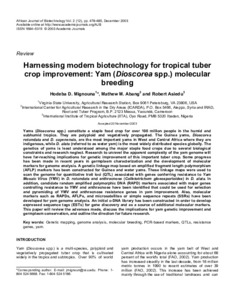| dc.contributor.author | Ekeleme, F. |
| dc.contributor.author | Chikoye, D. |
| dc.contributor.author | Akobundu, I.O. |
| dc.date.accessioned | 2019-12-04T11:23:55Z |
| dc.date.available | 2019-12-04T11:23:55Z |
| dc.date.issued | 2004-08 |
| dc.identifier.citation | Ekeleme, F., Chikoye, D. & Akobundu, I.O. (2004). Impact of natural, planted (Pueraria phaseoloides, Leucaena leucocephala) fallow and landuse intensity on weed seedling emergence pattern and density in cassava intercropped with maize. Agriculture, Ecosystems & Environment, 103(3), 581-593. |
| dc.identifier.issn | 0167-8809 |
| dc.identifier.uri | https://hdl.handle.net/20.500.12478/4214 |
| dc.description.abstract | Knowledge of magnitude and timing of weed seedling flushes is crucial in managing weeds adequately. Such knowledge is especially important for small-scale farmers in West Africa who spend a greater percentage of family labour in controlling weeds. This study assessed the composition, pattern and magnitude of seedling emergence of weed communities of a maize/cassava association in three types of fallow and four landuse intensities (continuous cropping or zero-fallow, 1 year of cropping followed by 1, 2, and 3 years fallow) over a 6-year period in Ibadan, Nigeria, West Africa. The study was carried out on a sandy loam (oxic paleustaff and psammentic ustorthent), <2% organic matter, and pH 6.2. Rainfall pattern at the study site is bimodal with average annual precipitation of 1250 mm. Weed seedling composition in the bush fallow treatment differed with year (e.g. seedling composition increased from 30 species in 1990 to 41 species in 1995) and was different from Leucaena leucocephala and Pueraria phaseoloides fallow treatments where volunteer seedlings of the respective fallow types were also present. At the initiation of the study, 1990, the seedling community was dominated by perennial weeds (60%). After 6 years, 84% of the weed seedlings were broadleaf (53% annuals and 31% perennials). Weed seedling emergence differed with type of fallow, landuse intensity and year (P<0.01). Weed seedlings emerged throughout the sampling period of 3–15 weeks after planting (WAP) crops. The highest number of weed seedlings emerged early in the season (3–5 WAP) followed by a second but smaller peak flush at 8–9 WAP and a decline over the rest of the sampling period in all types of fallow, landuse intensity, and years except in 1994. Natural bush and L. leucocephala fallow had more weed seedlings than P. phaseoloides fallow in all years except 1993 and 1995. Continuously cropped plots and plots cropped every other year had more emerged weed seedlings than plots that were cropped once followed by 2–3 years of uncropped fallow. |
| dc.language.iso | en |
| dc.subject | Shifting Cultivation |
| dc.subject | Fallow |
| dc.subject | Cropping Systems |
| dc.subject | Seedling Emergence |
| dc.subject | Cassava |
| dc.subject | Maize |
| dc.subject | Intercropping |
| dc.title | Impact of natural, planted (Pueraria phaseoloides, Leucaena leucocephala) fallow and landuse intensity on weed seedling emergence pattern and density in cassava intercropped with maize |
| dc.type | Journal Article |
| dc.type | Journal Article |
| dc.description.version | Peer Review |
| cg.contributor.crp | Roots, Tubers and Bananas |
| cg.contributor.crp | Maize |
| cg.contributor.affiliation | International Institute of Tropical Agriculture |
| cg.coverage.region | Africa |
| cg.coverage.region | West Africa |
| cg.coverage.country | Nigeria |
| cg.isijournal | ISI Journal |
| cg.authorship.types | CGIAR and advanced research institute |
| cg.iitasubject | Farming Systems |
| cg.accessibilitystatus | Limited Access |
| local.dspaceid | 99780 |
| cg.identifier.doi | https://doi.org/10.1016/j.agee.2003.11.001 |

